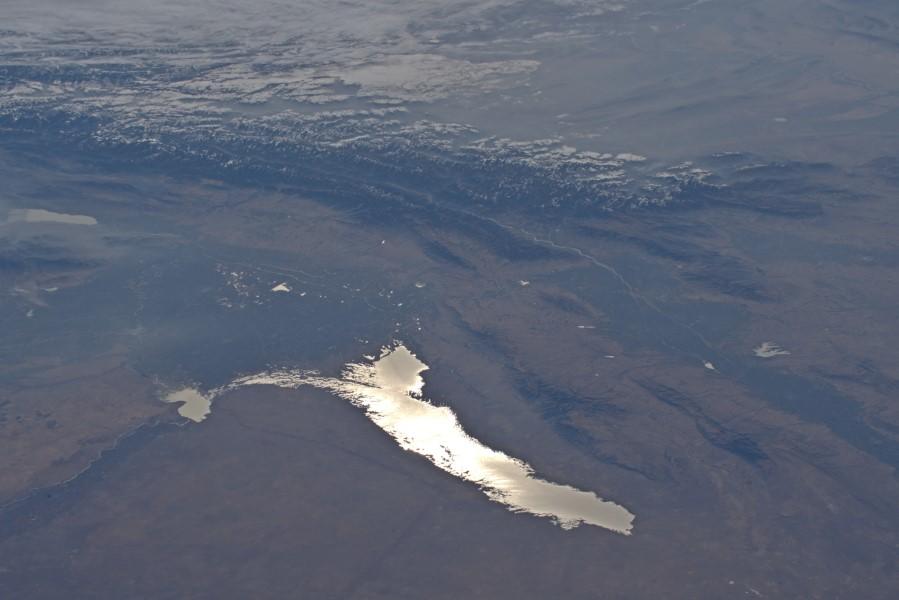[:ja]ルカ・パルミタノ宇宙飛行士がISSから撮影したウズベキスタンのサマルカンドとアイダール湖です。

サマルカンドは、アムダリヤ川の支流であるザラフシャン川河岸にある、中央アジア、ウズベキスタンの古都です。14世紀末から15世紀にかけてはティムール朝の首都として繁栄しました。ステップ気候から地中海性気候への移行部特有の抜けるような青空とモスクのラピスラズリ色から「青の都」と呼ばれます。大陸性気候のため、夏は乾燥して日中は40度近い酷暑となりますが、冬は寒く積雪もあるが年によって違いが大きく、過去には-25.4℃を記録しています。また、アイダール湖は、ソビエト連邦の灌漑計画の際に副産物として意図せず出来上がったものです。1950年代まではアルナサイ低地は塩分を多く含む干上がった土地であり、気温の高さから水が供給されず、干上がるような土地でした。1969年以降、アルナサイ低地はチャルダラ貯水湖の許容量を超えて流れこむ水の供給を受けるようになり、湖へと発展、現在では縮小を続けるアラル海に続き国内2番目の大きさの湖へと成長しています
地上の様子はこちらです。


参考文献: Luca Parmitano’s Tweet
地球俯瞰画像を見る: LiVEARTH
[Earthview Wonders] No.1179: Samarkand and Lake Aydar, Uzbekistan🇺🇿
Astronaut Luca Parmitano captured from ISS Samarkand and Lake Aydar, Uzbekistan.

Samarkand (Samarqand) is a city in southeastern Uzbekistan and one of the oldest continuously inhabited cities in Central Asia. Prospering from its location on the Silk Road between China and the Mediterranean, at times Samarkand was one of the largest cities of Central Asia. The city is noted as a centre of Islamic scholarly study and the birthplace of the Timurid Renaissance. In the 14th century, Timur (Tamerlane) made it the capital of his empire and the site of his mausoleum, the Gur-e Amir. Modern Samarkand is divided into two parts: the old city, and the new city, which was developed during the days of the Russian Empire and Soviet Union. The old city includes historical monuments, shops, and old private houses; the new city includes administrative buildings along with cultural centres and educational institutions. The Aydar Lake is part of the man-made Aydar-Arnasay system of lakes, which are expansive reservoirs of Soviet planning.
The local scenery on the ground is as follows.


Reference: Luca Parmitano’s Tweet
See earthview photo gallery: LiVEARTH[:en][Earthview Wonders] No.1179: Samarkand and Lake Aydar, Uzbekistan🇺🇿
Astronaut Luca Parmitano captured from ISS Samarkand and Lake Aydar, Uzbekistan.

Samarkand (Samarqand) is a city in southeastern Uzbekistan and one of the oldest continuously inhabited cities in Central Asia. Prospering from its location on the Silk Road between China and the Mediterranean, at times Samarkand was one of the largest cities of Central Asia. The city is noted as a centre of Islamic scholarly study and the birthplace of the Timurid Renaissance. In the 14th century, Timur (Tamerlane) made it the capital of his empire and the site of his mausoleum, the Gur-e Amir. Modern Samarkand is divided into two parts: the old city, and the new city, which was developed during the days of the Russian Empire and Soviet Union. The old city includes historical monuments, shops, and old private houses; the new city includes administrative buildings along with cultural centres and educational institutions. The Aydar Lake is part of the man-made Aydar-Arnasay system of lakes, which are expansive reservoirs of Soviet planning.
The local scenery on the ground is as follows.


Reference: Luca Parmitano’s Tweet
See earthview photo gallery: LiVEARTH[:]